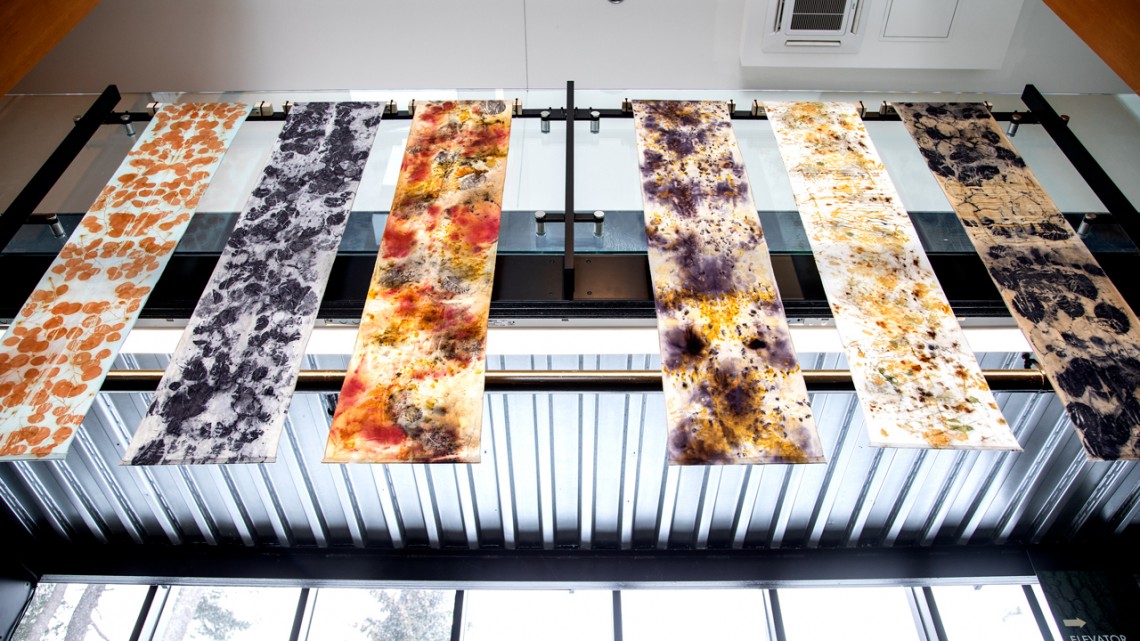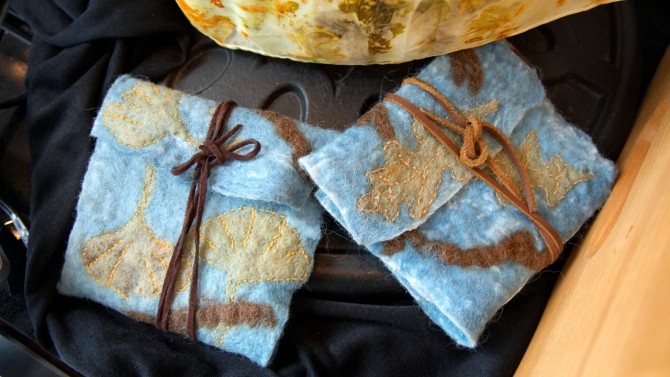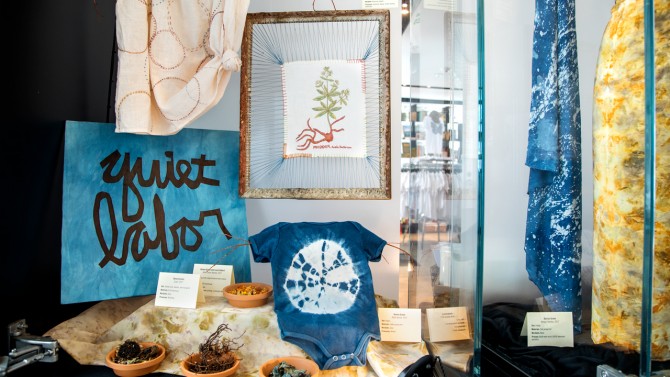
Charmeuse silk banners, by Blossom Schmitt '17, hang in the foyer of the Cornell Botanic Gardens' Nevin Welcome Center.
To dye for: Exhibit showcases naturally tinted textiles
By Krishna Ramanujan
Six colorful charmeuse silk banners hang from a balcony over the foyer of the Cornell Botanic Gardens’ Nevin Welcome Center. The banners are part of a new exhibit, “Quiet Labor,” featuring naturally dyed textiles, garments and artwork by students and local artists who contribute to the Cornell Natural Dye Studio, organized by Denise Green ’07, assistant professor of fiber science and apparel design in the College of Human Ecology.
“Quiet Labor” opened Feb. 7 and will run until June 25.
The banners were made by Blossom Schmitt ’17, an interdisciplinary studies major in the College of Agriculture and Life Sciences who took the class in her last semester at Cornell. She was invited back this year as a guest artist.
“The studio opened up my eyes to a whole world of textiles and that industry and ‘slow fashion’ and really understanding the process of how many chemicals and dyes it takes to make something,” Schmitt said. “I’ve been a florist for eight years and natural dyeing was a whole new outlet to explore, where I could be sustainable and thoughtful with it.”
For one banner, patterned with orange leaf-shapes from silver dollar eucalyptus, Schmitt used a technique called bundling. She laid the leaves on the silk fabric, rolled the cloth tightly around a tubular glass vase, and then steamed it, causing the orange leaf pigment to transfer and fix to the silk. The banner’s background color of faint blue-green came from dipping the cloth in a dye vat of indigo “tea.”
Natural dyes offer alternatives to chemical and synthetic dyes, which are the second-largest polluter of waterways globally, after agricultural pollution. Plant and insect dyes are derived from renewable, non-synthetic sources and have the potential to be more environmentally friendly than man-made dyes. But they have their drawbacks as well, Green said. Using them requires a lot of water, and some of the plants are toxic, which means more research and investment are needed to make them truly sustainable, she added.
“Many of our students are going to end up working in the fashion industry,” Green said. “If they can become disruptors in that industry and begin to think about and execute different ways of manufacturing and producing [dyes], they could be the game-changers who inspire the investment for research and the drive to make a more sustainable future for our industry.”
In the studio, most of the plants used for the dyes – including Japanese indigo (blue), bedstraw (red dye from roots, yellow from flowers), marigolds (yellow and orange), Hopi dye sunflower (black from seeds, purple-veined patterns from leaves) and madder root (red) – came from the Cornell Natural Dye Garden, located in the courtyard between the Human Ecology Building and Martha Van Rensselaer Hall.
The garden grew out of a Cornell Crowdfunding Campaign, with additional plants provided by the Cornell Botanic Gardens and local artist Sarah Gotowka at Earth Grown Shades. Other plants – diva dahlias (purple) and smoke bush leaves for ecoprints, for example – were sourced from collaborator Plenty of Posies, a flower farm in Newfield, New York, where Schmitt has worked for the last eight years.
Lilly Sullivan ’18, a clinical psychology major, used nuno felting to make a scarf and two notebook covers for Japanese mulberry paper notepads, each embroidered with cutouts of felt gingko leaves. Nuno dyed the felt with indigo (blue), black walnut (brown), osage orange and avocado pits (pink).
“The class has made me so much more aware of the potential of plants I wouldn’t normally look at for dyes,” including such materials as onion skins and avocado pits, Sullivan said. She is currently doing an independent study that will incorporate more natural dye work, she said.
This coming summer, Schmitt plans to sell her plant-dyed textiles at art festivals and flea markets. “I want to pursue this. I love it,” she said.
The title “Quiet Labor” has a mix of meanings: It refers to the massive amounts of hidden labor and costs it takes to produce industrial garments; the silence of plants; and the patient, intensive process it takes to work with natural dyes.
Media Contact
Get Cornell news delivered right to your inbox.
Subscribe


